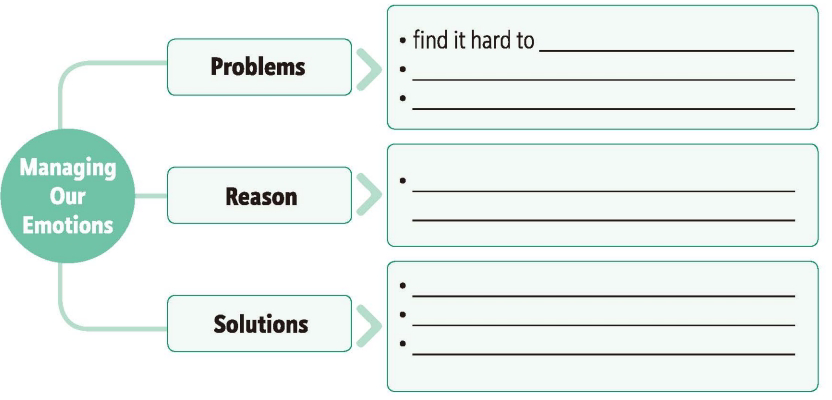单元主题:情感与情绪管理(Feelings and Emotions)
核心目标:帮助学生识别、描述和管理情绪,提升自我认知与社交能力。
一、核心教学内容
1. 情绪认知与表达
- 情绪类型:
- 正面情绪:快乐(happy)、兴奋(excitement)
- 负面情绪:愤怒(angry)、担忧(worried)、悲伤(sad)、失望(disappointed)
- 情绪触发场景(通过图片与对话练习):
- 收礼物(happy)、与父母争吵(angry)、输掉比赛(sad)、无事可做(bored)
- 情绪表达训练:
- 对话练习:描述情绪原因(如“I feel angry when someone uses my things without asking.”)
- 情景模拟:家庭健康担忧、朋友失望、比赛胜利等
2. 青少年情绪问题与原因
- 常见问题:
- 难以理解并控制情绪(find it hard to understand and control emotions)
- 长期压抑情绪(hold on to emotions for a long time)
- 隐藏真实感受(pretend to be cool when nervous)
- 深层原因:
- 生理变化:大脑与身体快速发育(physical changes cause emotional ups and downs)
- 心理阶段:从儿童向成人过渡(transition from childhood to young adulthood)
3. 情绪管理策略
- 三步法:
- 识别情绪(recognise emotions):承认感受而非忽视(don’t turn a deaf ear to feelings)
- 表达情绪:写日记或与朋友/父母/老师沟通(write down feelings or talk about them)
- 向前看:避免沉溺过去(do not think too much about the past)
- 实用技巧:
- 冷静沟通(communicate calmly)
- 接纳自我(accept imperfections, e.g., “I like my personality but not my hair.”)
二、语言技能训练
1. 语法重点:过去进行时(Past Continuous)
- 用法:描述过去某一时刻正在进行的动作(背景动作)。
- 例句:
- “While she was preparing for her test, her sister was watching TV.”
- “We were pretending to be cool when we were feeling nervous.”
- 例句:
- 连接词:
- when/while 引导背景动作(e.g., “When she was getting dressed, she looked in the mirror.”)
2. 词汇与表达
- 情绪管理相关词汇:
- recognise, manage, hold on to, turn a deaf ear to, cause
- 自我描述词汇:
- 外貌:tall/slim/wavy hair/well built
- 性格:sociable/humorous/confident/shy
3. 功能性对话
- 道歉场景(Making an Apology):
- 表达歉意:
“I’m so sorry! I feel really bad about…”
“I didn’t mean to hurt you.” - 回应道歉:
“It’s not all your fault.” / “Don’t be too hard on yourself.”
- 表达歉意:
三、拓展活动与任务
1. 阅读与反思
- 主题文章:
- 《Managing Our Emotions》:分析青少年情绪波动原因与解决方案

- 《Please Be Proud of Me!》:讨论父母比较行为的影响及沟通建议
- 《How Do You Feel About Yourself?》:探讨自我接纳(如Jenny从自卑到自信的转变)
- 《Managing Our Emotions》:分析青少年情绪波动原因与解决方案
- 阅读俱乐部:
- 《Don’t Be Afraid!》:通过排球队员Annie的故事强调坚持的重要性
- 《Let Me Tell You How I Feel》:呈现青少年与父母的相互视角
2. 写作任务
- 情感经历记叙文(Essay on an Emotional Experience):
- 结构指导:
① 引入情绪问题 → ② 描述事件与感受 → ③ 解决过程 → ④ 经验总结 - 范例:《Being Too Emotional Is Not Helpful》(Lucy因朋友误解过度反应后学会沟通)
- 结构指导:
3. 合作项目
- 治愈系漫画书创作(Comic Book to Heal):
- 任务:小组创作帮助青少年管理情绪的漫画
- 要求:包含情绪问题、管理策略、单元所学语言
四、单元总结与自评
- 核心收获:
- 情绪类型识别 → 情绪归因分析 → 管理策略实践
- 自我反思工具:
- 完成句子:“I feel happy when… I feel sad when…”(记录情绪触发点)
- 语法应用:用过去进行时描述经历(e.g., “When I was taking the test, I felt nervous.”)
教学特色
- 多模态训练:结合对话、歌曲(“All things happen for a reason”)、漫画创作强化情感表达。
- 真实情境:聚焦青少年高频情绪场景(家庭矛盾、朋友关系、自我形象焦虑)。
- 跨技能整合:将语法(过去进行时)与情绪描述结合,提升语言应用能力。
此单元通过系统性的认知-分析-实践框架,帮助学生构建情绪管理能力,同时强化英语综合技能。
发表回复